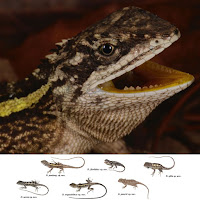 |
| Diploderma angustelinea sp. nov. Wang, Ren, Wu, Che, Siler Diploderma aorun sp. nov. Wang, Jiang, Zheng, Xie, Che, Siler Diploderma flavilabre sp. nov. Wang, Che, Siler Diploderma panchi sp. nov. Wang, Zheng, Xie, Che, Siler Diploderma panlong sp. nov. Wang, Che, Siler Diploderma qilin sp. nov. Wang, Ren, Che, Siler in Wang, Ren, Wu, Jiang, ..., Siler et Che, 2021. DOI: 10.1111/jzs.12414 |
Abstract
Cryptic diversity not only introduces confusion to taxonomic studies, but it also poses major challenges to conservation and environmental legislation. One such troubling group are the Mountain Dragons in the genus Diploderma in Southwest China. Previous studies have suggested that the genus contains considerable cryptic diversity, particularly in the D. flaviceps complex. Owing to taxonomic confusion, micro‐endemic lineages are still neglected by the Chinese wildlife protection laws, despite their urgent conservation needs. Combining multivariate morphological and multi‐locus phylogenetic data, we provide the first integrative systematic revision of the genus Diploderma. Specifically, we confirm that the six examined populations of D. cf. flaviceps from the upper Jinsha and Yalong River Valleys in Sichuan and Yunnan Provinces represent six cryptic, undescribed lineages, and we describe each of them as a new species. With the updated taxonomy and distribution information, we discuss the taxonomy of the D. flaviceps complex in Southwest China, provide an updated diagnostic key along with distributional ranges for all species of the genus, and discuss some of the suspicious records of other congeners in China. Lastly, we evaluate the IUCN status of each of the six new species and highlight the major challenges for Diploderma conservation in China due to delayed environmental legislation and misleading conservation assessments.
Keywords: Draconinae, IUCN, Japalura sensu lato, taxonomy, Wildlife Protection Act of China
Diploderma angustelinea sp. nov. Wang, Ren, Wu, Che, Siler
Etymology: The Latin specific name, “angustelinea”, comprises two parts: anguste meaning “narrow” and linea meaning “stripe” or “line.” Together, the specific name describes the diagnostic narrow, thin, dorsolateral stripes present in the species.
We recommend Narrow‐striped Mountain Dragon as its English common name
and 细纹龙蜥 (Pinyin: Xi Wen Long Xi) as its Chinese common name.
Diploderma aorun sp. nov. Wang, Jiang, Zheng, Xie, Che, Siler
Etymology: The species name “aorun” is derived from the name of the legendary Dragon Lord in Chinese mythology (Chinese 敖闰, Pinyin: Ao Run), who is the guardian of the West Ocean and is responsible for creating precipitation. We name the new species after the guardian of the ocean in the hope that the recognition of its endangered status will bring protection to the fragile valley habitats that the species is endemic to, just like the dragon lord protecting its realm in the mythology.
We recommend Aorun Mountain Dragon as its English common name
and 敖闰龙蜥 (Pinyin: Ao Run Long Xi) as its Chinese common name.
Diploderma flavilabre sp. nov. Wang, Che, Siler
Etymology: The Latin species name, flavilabre, means “yellow‐lipped,” which describes the diagnostic dark spectrum yellow coloration of inner lips of the species.
We recommend Yellow‐lipped Mountain Dragon as its English common name
and 黄唇龙蜥 (Pinyin: Huang Chun Long Xi) as its Chinese common name.
Diploderma panchi sp. nov. Wang, Zheng, Xie, Che, Siler
Etymology: The species name “panchi” is derived from the name of female dragons (Chinese蟠螭, Pinyin: Pan Chi) in the ancient Chinese literature,《汉书·司马相如传》.
We recommend Panchi Mountain Dragon as its English common name
and 蟠螭龙蜥(Pinyin: Pan Chi Long Xi) as its Chinese common name.
Etymology: The specific name “panlong” is derived from the Chinese word 蟠龙 (Pinyin: Pan Long), from the ancient Chinese literature,《广雅》(Pinyin: Guang Ya). The name refers to dragons that are terrestrial and are not able to fly, which matches the terrestrial lifestyle of the new species.
We recommend Pan Long Mountain Dragon as its English common name
and 蟠龙龙蜥 (Pinyin Pan Long Long Xi) as its Chinese common name.
Diploderma qilin sp. nov. Wang, Ren, Che, Siler
Etymology: The specific name, qilin, is derived from the Chinese name of the legendary beast (麒麟). According to Chinese mythology, Qilin is the son of the dragon, with a golden yellow body coloration, which matches the diagnostic gular color of the new species.
We suggest its English common name as Qilin Mountain Dragon
and Chinese common name as 麒麟龙蜥 (Pinyin: Qi Lin Long Xi).
Kai Wang, Jinlong Ren, Jiawei Wu, Ke Jiang, Jieqiong Jin, Shaobing Hou, Puyang Zheng, Feng Xie, Cameron D. Siler and Jing Che. 2021. Systematic Revision of Mountain Dragons (Reptilia: Agamidae: Diploderma) in China, with Descriptions of Six New Species and Discussion on Their Conservation. Journal of Zoological Systematics and Evolutionary Research. 59(1); 222-263. DOI: 10.1111/jzs.12414
Combining multi‐locus genetic and morphological data, we present the most comprehensive phylogeny of the genus Diploderma and provide the first systematic revision of the D. flaviceps complex from Southwest China. As results, we describe six new species from the upper Jinsha and Yalong Valleys, provide IUCN conservation assessments for each new taxon, update the diagnostic key to all species of the genus, and discuss current conservation challenges the genus in China due to the unsettled taxonomy, misleading conservation assessments, and delayed law legislation.



